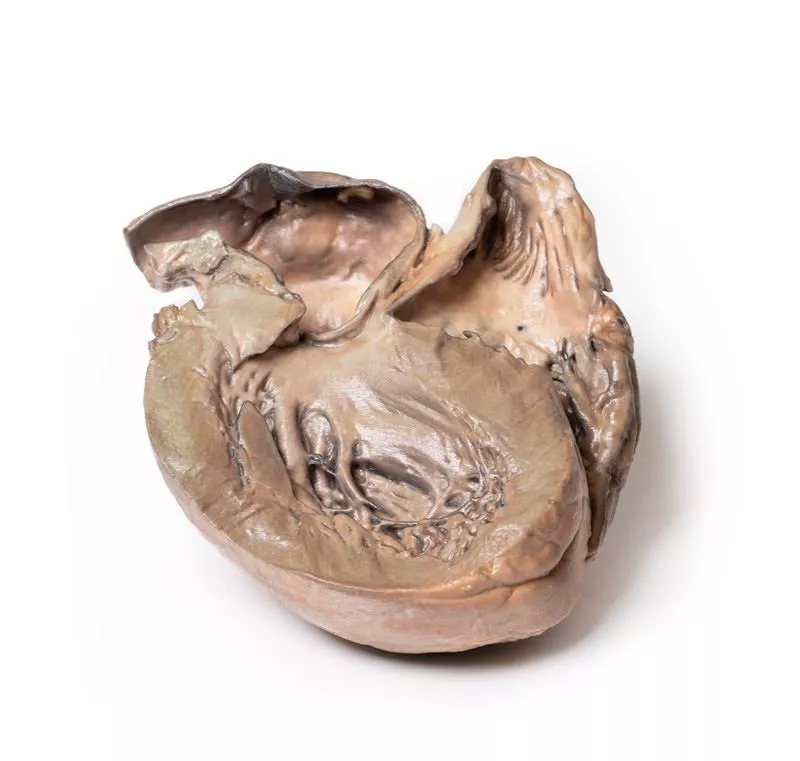Produktinformationen "Acute Bacterial Endocarditis"
Klinische Vorgeschichte
Ein 15-jähriger Junge entwickelte Husten mit Auswurf, gefolgt von hohem Fieber und Brustschmerzen wenige Tage vor Aufnahme im komatösen Zustand. Bei der Untersuchung fiel ein frühes diastolisches Geräusch im Aortenbereich auf, das entlang des linken Brustbeins ausstrahlte. Trotz antibiotischer Therapie verschlechterte sich sein Zustand schnell und er verstarb. Blutkulturen zeigten Staphylococcus aureus.
Pathologie
Das kleine Herzpräparat zeigt den linken Ventrikel und die zugehörigen Klappen. Die nicht-koronare Klappe der Aortenklappe ist ulzeriert, perforiert und mit brüchigen Vegetationen bedeckt. Unterhalb dieser Klappe erstreckt sich eine Perforation in den rechten Vorhof oberhalb der Trikuspidalklappe. Eine weitere Aortenklappe ist verdickt. Dies ist eine akute bakterielle Endokarditis mit Klappen- und Vorhof-Kammer-Perforationen.
Weitere Informationen
Akute bakterielle Endokarditis ist eine schwere Infektion der Herzinnenhaut oder Klappen, die meist durch eine vorgeschädigte Endotheloberfläche entsteht. Staphylococcus aureus ist sehr virulent und kann auch gesunde Klappen infizieren. Die Infektion führt zur Aggregation von Thrombozyten und Fibrin, wodurch Vegetationen entstehen, die durch Aktivierung des Gerinnungssystems und Entzündungen wachsen. Diese können embolisieren und Infektionen in anderen Organen verursachen. Risikofaktoren sind Klappenerkrankungen (z. B. rheumatisch oder angeboren), künstliche Klappen oder frühere Herzoperationen. Die Diagnose erfolgt klinisch, durch Blutkulturen und Echokardiografie (transthorakal, transösophageal). Die Behandlung umfasst Antibiotika, Antikoagulanzien und gegebenenfalls chirurgische Eingriffe.
Ein 15-jähriger Junge entwickelte Husten mit Auswurf, gefolgt von hohem Fieber und Brustschmerzen wenige Tage vor Aufnahme im komatösen Zustand. Bei der Untersuchung fiel ein frühes diastolisches Geräusch im Aortenbereich auf, das entlang des linken Brustbeins ausstrahlte. Trotz antibiotischer Therapie verschlechterte sich sein Zustand schnell und er verstarb. Blutkulturen zeigten Staphylococcus aureus.
Pathologie
Das kleine Herzpräparat zeigt den linken Ventrikel und die zugehörigen Klappen. Die nicht-koronare Klappe der Aortenklappe ist ulzeriert, perforiert und mit brüchigen Vegetationen bedeckt. Unterhalb dieser Klappe erstreckt sich eine Perforation in den rechten Vorhof oberhalb der Trikuspidalklappe. Eine weitere Aortenklappe ist verdickt. Dies ist eine akute bakterielle Endokarditis mit Klappen- und Vorhof-Kammer-Perforationen.
Weitere Informationen
Akute bakterielle Endokarditis ist eine schwere Infektion der Herzinnenhaut oder Klappen, die meist durch eine vorgeschädigte Endotheloberfläche entsteht. Staphylococcus aureus ist sehr virulent und kann auch gesunde Klappen infizieren. Die Infektion führt zur Aggregation von Thrombozyten und Fibrin, wodurch Vegetationen entstehen, die durch Aktivierung des Gerinnungssystems und Entzündungen wachsen. Diese können embolisieren und Infektionen in anderen Organen verursachen. Risikofaktoren sind Klappenerkrankungen (z. B. rheumatisch oder angeboren), künstliche Klappen oder frühere Herzoperationen. Die Diagnose erfolgt klinisch, durch Blutkulturen und Echokardiografie (transthorakal, transösophageal). Die Behandlung umfasst Antibiotika, Antikoagulanzien und gegebenenfalls chirurgische Eingriffe.
Erler-Zimmer
Erler-Zimmer GmbH & Co.KG
Hauptstrasse 27
77886 Lauf
Germany
info@erler-zimmer.de
Achtung! Medizinisches Ausbildungsmaterial, kein Spielzeug. Nicht geeignet für Personen unter 14 Jahren.
Attention! Medical training material, not a toy. Not suitable for persons under 14 years of age.































